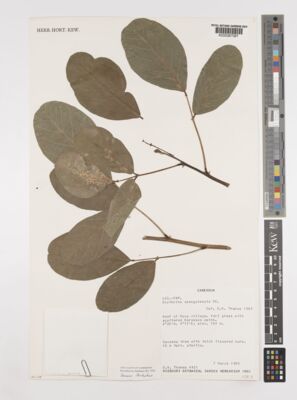Geography and distribution
Native to Senegal, Gambia, Guinea, Guinea-Bissau, Sierra Leone, Liberia, Mali, Burkina Faso, Ivory Coast, Niger, Ghana, Togo, Benin, Nigeria and Cameroon.
Description
Overview: A tree growing up to 7 m tall, rarely to 15 m, with deeply fissured, corky bark. The branches and bark are armed with slightly hooked spines up to 10 mm long.
Flowers and fruits of Erythrina senegalensis
Leaves: The leaves are composed of three leaflets, each measuring 5-15 × 4-10 cm and having a thorny stalk.
Flowers: The flowers appear in large groups at the end of the branches, when the tree is leafless (in the first half of the dry season). The flowers are bright red and 4-5 cm long.
Fruits: The fruit is a bent, twisted and slightly hairy pod, 7-15 × 1 cm. It is constricted between the seeds, which are bright red.
Reproduction is by seed, but farmers also propagate the tree by taking cuttings. There are no known varieties or subspecies. The corky bark enables the tree to withstand the fires which regularly pass over the West African savanna.
Common names
coral tree, coral flower (English); arbre corail, érythrine du Sénégal (French); matiéréré (Badyara); figéra, figẹ́ru, figira, figra, msis (Balanta); kidolin, si foli (Banyun); a-térif, a-tiéril, a-tiéris (Basari); gi-tyelὲr (Bedik).
Threats and conservation
There are no known threats to this coral tree, which is quite widespread and widely planted, though the extensive use of its bark for medicine often causes trees to be almost stripped of their bark.
Conservation assessments carried out by Kew
Erythrina senegalensis is being monitored as part of the Sampled Red List Index Project, which aims to produce conservation assessments for a representative sample of the world's plant species. This information will then be used to monitor trends in extinction risk and help focus conservation efforts where they are needed most.
Uses Traditional medicine
This coral tree has a large number of traditional medicinal uses in West Africa. The bark and roots are used against stomach disorders and as a general tonic, and the bark and leaves are used for dressing wounds.
Erythrina senegalensis (coral tree) Other uses
The wood is used for making knife handles.
The seeds are made into necklaces and used as game counters, despite being poisonous.
Erythrina senegalensis is planted as an ornamental and used for hedging.
Millennium Seed Bank: Seed storage
Kew's Millennium Seed Bank Partnership aims to save plant life world wide, focusing on plants under threat and those likely to be of most use in the future. Seeds are dried, packaged and stored at a sub-zero temperature in our seed bank vault.
A collection of Erythrina senegalensis seeds is held in Kew's Millennium Seed Bank based at Wakehurst in West Sussex.
Search Kew's Seed Information Database for further information on Erythrina senegalensis seeds
Cultivation
This coral tree can be grown easily and quickly from woody cuttings.
This species at Kew
Spirit-preserved specimens of Erythrina senegalensis are held in Kew's Herbarium, where they are available to researchers by appointment. The details of some of these specimens can be seen online in Kew's Herbarium Catalogue.
Coral tree pods and seeds are held in Kew's Economic Botany Collection.




